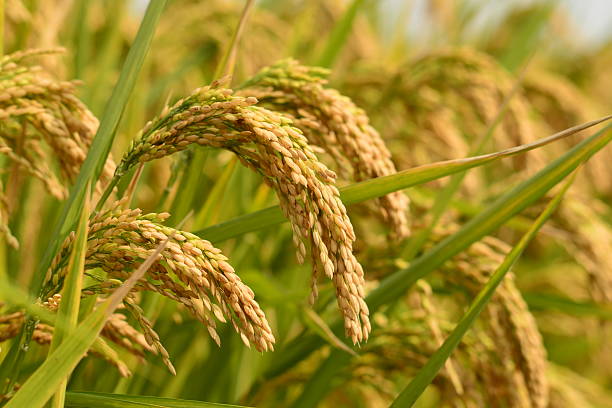Paddy Farming
From Seed to Global Shelf—It's not farming, it's future-building.
Follow our step-by-step guide to grow export-quality paddy and transform your farming venture.

Follow our step-by-step guide to grow export-quality paddy and transform your farming venture.

Objective: Ready your terrain and tools.
The foundation of successful paddy farming begins with selecting the right land and preparing it properly. Paddy thrives in lowland areas with good water retention capabilities.
"Testing soil pH was a game-changer for me. My yield increased by 30% after proper pH adjustment!"
"Don't skimp on leveling your field. Even a slight slope can cause uneven water distribution and affect growth."
Objective: Secure high-quality input.
Seed selection is critical for successful paddy cultivation. High-quality seeds ensure better germination rates, disease resistance, and ultimately higher yields. The right variety selection depends on your local climate, soil conditions, and market demands.
"I always test my seeds by soaking them in water with 2% salt solution. I've saved thousands by eliminating poor quality seeds before planting."
"Don't skip pre-sprouting! It gives seeds a head start and improves germination by 30%. Just be careful not to let sprouts grow too long before sowing."
Objective: Grow a healthy young batch.
The nursery stage is crucial for developing healthy seedlings before transplantation to the main field. This phase ensures uniform growth and better establishment of seedlings, resulting in higher yields and reduced seed requirements.
"I apply neem cake powder (100g/sqm) to the nursery soil. It acts as an organic pest repellent and provides slow-release nutrients to seedlings."
"For transplanting, I use the 'square grid' method with a rope marked at 20cm intervals. It ensures perfect spacing and makes weeding with a mechanical weeder much easier later."
Objective: Push for vigorous growth.
Proper field management is essential for healthy paddy growth and optimal yields. This phase involves maintaining water levels, nutrient management through fertilization, weed control, and pest monitoring to ensure the crop thrives.
"I practice alternate wetting and drying (AWD) irrigation. It saves 30% water and reduces methane emissions while maintaining yields. Just install a 30cm perforated pipe to monitor water levels."
"Installing yellow sticky traps and pheromone traps around the field helps me detect pest infestations early. Early detection means less damage and reduced need for interventions."
Objective: Maximize grain yield and quality.
Harvesting at the right time and proper post-harvest handling are crucial for maintaining grain quality and minimizing losses. This phase focuses on capturing the maximum yield from your field and preserving grain quality through proper drying and storage.
"I use a simple digital moisture meter ($20 online) to check grain moisture before storage. It's a small investment that has saved me from major losses due to fungal issues in storage."
"Placing neem leaves between layers of rice bags acts as a natural insect repellent during storage. It's chemical-free and very effective for maintaining organic certification."
Objective: Turn raw paddy into export-quality rice.
Processing transforms raw paddy into marketable rice through milling, which removes the husk and bran layers. For export markets, proper processing, grading, and packaging are essential to meet international standards and command premium prices.
"Investing in my own mini rice mill saved me 30% in processing costs. For small farmers, a shared mill with 5-6 neighbors can be more cost-effective than commercial milling."
"Premium packaging with QR codes linking to our farm story and cultivation practices helped us secure European buyers who pay 15% more than the standard market rate."
Objective: Meet export-grade benchmarks.
Quality assurance is critical for accessing premium export markets. This phase ensures your rice meets international safety and quality standards through rigorous testing and proper documentation, allowing you to command higher prices in global markets.
"I keep samples from each batch for 12 months as a reference. This has saved me twice when dealing with quality disputes from international buyers."
"Using a simple QR code system that links to our farm's cultivation practices and test reports increased buyer trust. It costs nearly nothing but adds significant perceived value."
Objective: Prepare for market entry.
Setting up the legal framework and documentation for exporting is a critical step for accessing international markets. This phase ensures you have all the necessary registrations, certifications, and partnerships to legally and efficiently export your rice.
"I formed a farmer producer organization (FPO) with 30 other paddy farmers. Pooling our resources helped us afford export certifications and increased our bargaining power with buyers."
"Getting organic certification was expensive and took 3 years, but now our rice commands a 40% premium in European markets. The long-term returns justified the investment."
Objective: Create pull in the global market.
The final phase focuses on marketing, selling, and distributing your rice to international buyers. Building a brand identity, finding reliable buyers, and establishing sustainable business relationships are key to long-term success in export markets.
"We created video stories of our farm and traditional farming methods, sharing them on social media. This digital presence attracted premium buyers from Japan who were looking for authentic, traditionally-grown rice."
"Start with smaller orders to build relationships and trust. My first export was just 500kg, but that buyer now takes 20 tons yearly because we proved our reliability and consistency."
Join our monthly online workshops covering advanced farming techniques, new export regulations, and market trends.
View ScheduleGet personalized guidance from agricultural experts and export consultants through one-on-one virtual sessions.
Book ConsultationConnect with other export-oriented farmers, share experiences, and solve problems together in our online forum.
Join CommunityAccess our database of verified international rice buyers and distributors looking for quality products.
Explore Network